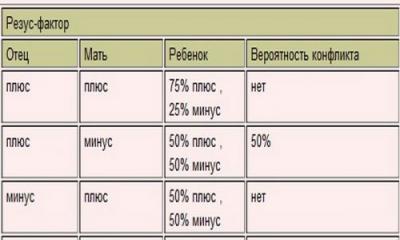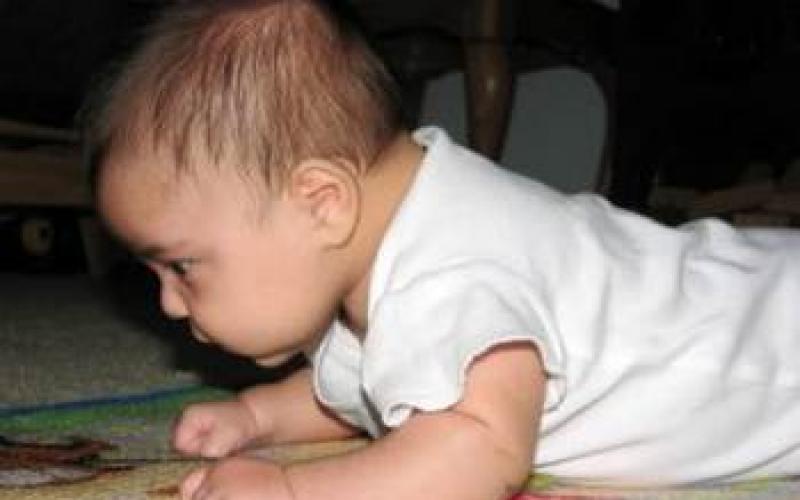Is it worth worrying if a baby doesn't hold his head well at 3 months? The organism of each crumb is individual: what for one will be a deviation, for another - the norm. However, in any case, if its development raises doubts and concerns among parents, you should consult a doctor.
How does a baby develop up to 3 months
The newborn does not yet know how to control his body. All his movements are chaotic, disordered, carried out reflexively. When the tummy is up, its head turns to the right or left. If you pull it up by the hands, it will lean back. If you touch his palms with his fingers, he will squeeze them reflexively.
But gradually, the baby begins to control the body, its muscles get stronger. By 3-4 months he already knows a lot. Lying on your back, forward and to the sides. Arms and legs are positioned as it is necessary for him, examines, plays with them, tries "by the teeth". This is the period when the child begins to hold his head independently in any position. Lying back up, the baby can lean on the forearms.
Also, by 3-4 months, the child learns to grab, take objects with pens. This is the period when, already consciously, any emotions are reflected on his face. Lying on his back, he can independently.
If any of the above is missing, parents begin to worry. Particular concern arises if there are problems with the head. The feelings are quite understandable. However, there is cause for concern or not, only a doctor can say for sure.
How and when does the baby begin to fix the head
There is no clear standard age. However, all healthy children develop this skill in approximately the same way:
1
The first attempts to raise the head of the baby are already in 2-3 weeks of lifeif you put it on your stomach. It is a natural reflex not to suffocate.
 At 3 months, babies already achieve their first successes, but they still need a head safety net
At 3 months, babies already achieve their first successes, but they still need a head safety net 2
A month old baby does not keep his head upright, but is already trying. Lying on my stomach 1-1.5 month old baby knows how to raise the head at an acute angle and hold it for up to a minute.
3
At 2 months of ageif you pull the baby by the handles, it will be gone. Lying with the tummy up, the baby is struggling to fix her in an upright position. If a child at 2 months does not hold his head, this is not yet a reason for panic.
Gulba OV, pediatrician, Private clinic "Pervaya", Tomsk
A 3 month old baby, even with normal development, needs to be shown to a neurologist. If you do not hold your head, the problem can be solved quite easily with a course of massage, physiotherapy.
The mother can do the massage herself at home - so the baby will be even calmer.
4
At 3 months of age the baby usually tries to fix the head in any position. However, the muscles are not yet strong enough. Therefore, when he is in an upright position, it is better to support the neck.
5
4 months - the age at which the child begins to hold his head confidently... He not only fixes it in any position, but also turns it in all directions, studying the world around. Leaning on his tummy, the baby calmly lifts the upper part of the body on the arms.
A discrepancy with such a scheme for several weeks is not terrible. But if suddenly a child does not hold his head well at 4 months, you should definitely consult a doctor. Read what else a child should be able to do at 4 months.
Why is the problem
It happens that a child at 3 months does not hold his head at all. And he doesn't even try. This is a reason to see a doctor. The reason for this deviation is that it does not control the muscles of the neck. This is influenced by such factors:
Often the pride and delight of parents causes early development children, the ability to raise the head in a month and a half. Since the child does not have to keep his head up for a month, this is also a reason to see a doctor. Too early development can be caused by muscle hypertonicity or high intracranial pressure.
How to help your baby
First of all, if a child does not hold his head well at 3 months, you should contact a pediatrician. The pediatrician will tell you what to do, or refer you to the right specialist. So, in case of prematurity, birth trauma, an examination by a pediatric neuropathologist may be necessary... If the baby has problems with nutrition, weight gain, it is worth consulting with a feeding specialist. Most often, exercises and massage are enough to correct the situation.
 Fitball exercises also have a beneficial effect on the baby's digestive system and relieve colic
Fitball exercises also have a beneficial effect on the baby's digestive system and relieve colic Here are some exercises that help strengthen your neck muscles:
- Put the baby with his stomach on the palms of an adult so that one hand is under his chest, the other under his hips. Raise and lower it vertically.
- Put on the palm of your hand, face down, wiggle, alternately lifting your head, then your ass.
- Put on a large ball (fitball). One adult should fix the baby by the hips, the second by the handles. Swing gently on the ball. Other fitball exercises for children can be viewed.
Eremenko V.N., neurologist, Medical holding "Medica", St. Petersburg
Up to six months, most problems of this nature are solved by physiotherapy, massage, gymnastics. Medicines are prescribed for serious neurological disorders.
Therefore, if you doubt the appropriateness of the prescribed treatment, you should consult another doctor.
In addition, it is imperative to put the baby with its stomach down for a short time every day, several times a day. It will be useful. It will be easier for the baby to hold the head under water, and the muscles will get stronger faster.
You should not lay the baby down with his tummy down immediately after eating or during illness. If the baby is capricious, you can distract his attention with bright toys, singing, affectionate intonations, stroking.
Holds my head, but wrong
It happens when a child holds his head, but not correctly. In this case, he tilts or turns it to one side.
3 reasons for improper head holding:
1
With such a violation, you should consult an orthopedist. Incorrect holding of the head can be a symptom of paresis of the muscles of the neck. In simple terms -. This pathology is not common; it occurs later on a birth injury or during pregnancy with complications.
To get rid of torticollis, physiotherapeutic procedures or surgery can be prescribed. Sometimes it may be necessary with which the baby will sleep.
2
When a child does not hold his head well at 3 months ,
inclines her, but torticollis is excluded, the reason may be. Then the doctor will prescribe a light home massage (and show you how to do it), exercises under water.
3
If the baby holds his head incorrectly from time to time, but at the same time knows how to hold it as it should, this, moreover, is not a reason for panic. He may just feel comfortable. And when the baby kept his head all the time, and then suddenly switched to the wrong position, it is worth asking the doctor's advice.
3 ways to prevent
In order for a newborn to develop correctly, harmoniously from the very moment of birth, it is necessary to deal with him. This is not only communication, love of parents, but also massage, gymnastics, educational games.
 All classes with a baby are best done in the morning, after feeding after 1-1.5 hours
All classes with a baby are best done in the morning, after feeding after 1-1.5 hours When wondering how to teach a child to hold his head, it is important to understand that everything has its time. It will not work to teach you how to do something if the time has not come yet... Trying too hard can even hurt.
Therefore, all gymnastics, all exercises aimed at developing the cervical muscles should be, above all, a fun game, give pleasure:
- To strengthen the cervical muscles, you need to start laying the crumb for a short while with the tummy down in the first weeks of his life, when the umbilical wound heals. If you do this before a feed, then a simple exercise can help reduce intestinal gas even more.
- To prevent problems with the neck, its curvature, it is necessary to avoid positions when the head is thrown back or to the side. Muscles are still weak up to 3-4 months. Therefore, in order not to harm, you need to hold the baby's head, lifting him into your arms.
- A good prevention and a way to strengthen the neck muscles will be daily exercises with a large ball - as well as exercises in the water. It is not necessary to use the pool for this. Up to six months, a deep baby bath or a regular bath will be enough.
Valieva A.A., pediatric neurologist, Clinical Hospital of JSC "Russian Railways", Tver
You need to put on the tummy as often as possible. Better before every meal. If the baby is crying on a hard surface, you can start with soft ones, put on the stomach to the parents. Gradually he will get used to it.
This position stimulates the development of the muscles of the back and neck, develops the motor abilities of the crumb.
Conclusion
It is impossible to say for sure when the child starts to hold his head. Someone as early as 2 months can lift it confidently, and this will not be a sign of hypertension. The other is just studying at 4 months. However, this does not mean that parents should let everything go by themselves, explaining developmental deviations by individual characteristics.
It's always better to ask the doctor once more than to regret it later. And, of course, it is necessary to deal with the baby - from the very birth. Do it with a good mood and a smile, so that even a simple exercise becomes a game and brings joy to him and his parents.
In contact with
In most child development forums, young mothers are often asked about when a child starts to hold his head. It is very difficult to answer this question exactly, since each child develops individually. The first year of the child is rich in the acquisition of vital skills. And holding the head is no exception.
But these skills come on time. Unfortunately, many mothers begin to wind themselves up if the neighbor's boy is already free to hold his head, and her toddler has just begun to turn it to one side. To allay concerns about this, we will figure out when newborns begin to hold their heads.
Every mother wants her child to be the best in everything. But you still need to worry not only if the baby lags behind peers. Sometimes too early development is a sign of pathology. This rarely happens, but a consultation with a pediatrician will not hurt.
When the time comes that the child holds his head on his own
Many parents believe that the neck muscles have grown strong enough at the moment when the newborn baby is confidently holding his head in the "column" position. In fact, this is not the case. You can talk about this only when the child keeps his head raised in the "on the tummy" position. It comes at about three months. But this period may vary.
So that you don't panic, consider the development of this skill in different periods:
- The first days of the baby. During this period, be sure to support him under the head, as the child's muscles are very weak. After the navel has healed, it is sometimes possible to lay the baby on the tummy;
- One to two months. In a month, the baby can usually keep the head in balance for a few seconds. By the eighth week, he can already pull his head to his chest. But you still need to be careful, since the tension of the neck muscles during this period is short;
- Three to four months. At this age, coordination of movements improves. Lay your baby on the tummy more often. You can also pull it up by the handles from a prone position. This is a great exercise for the child to hold their head;
- Five to six months. At this age, children usually already hold their head well and can turn it in different directions.
 1) What to do if the child does not pronounce the letter P, we tell in the article at the link.
1) What to do if the child does not pronounce the letter P, we tell in the article at the link.
2) Up to what age is it recommended to swaddle a newborn?
What to do when a baby does not start holding his head at three months
As previously stated, every child is different. But still, at three months, he should already hold his head for at least a few seconds. If this does not happen, then the reasons may be as follows:
- The appearance of the baby was accompanied by difficult childbirth or he had neurological problems. In this case, a doctor's consultation is imperative;
- Low neck muscle tone. It also requires a consultation with a neurologist. Most likely, he will prescribe a massage to keep the child's head;
- The child was not often laid out on the tummy, which is why his neck muscles were not sufficiently strengthened;
- Developmental delays can often occur in babies with low birth weight or in premature babies. In this case, you need to consult a pediatrician;
- The kid holds his head, but not straight, but at an angle. In this case, a special massage is required.
If any deviations are detected, be sure to consult a doctor. It is important to understand that you need to identify the problem immediately. In the future, the treatment of neurological diseases is very difficult!
How to teach a child to hold their head on their own
For prevention, experts recommend a certain set of exercises to keep the baby's head.
You need to start small. If the baby still does not know how to hold the head, then put in front of him bright toy... Lay it on your tummy and put your hand on your forehead. Gently lift the head so that the toy is visible. Hold it in this position for about five seconds. Such repetitions should be done 5-6.

If during the exercise the child tries to hold his head himself, then gently remove the palm, while insuring him. If the baby is already starting to hold his head, more often stimulate him to do this.
Also pay attention to your neck muscles. Place the baby on a flat surface on the back with a pillow. Lift it by the shoulders, holding it for a few seconds. Over time, he will raise his head after his shoulders.
It is important to understand that the exercises described are not some kind of panacea, and your little one will immediately raise his head. Remember, everything has its time, and you do not need to rush things. You can only interfere with the natural process if a doctor has consulted!
What to do when your baby starts holding her head too early
 Modern children develop much faster. Therefore, it may be the norm when the toddler holds his head in a month. But this happens extremely rarely, so a consultation with a neurologist is imperative.
Modern children develop much faster. Therefore, it may be the norm when the toddler holds his head in a month. But this happens extremely rarely, so a consultation with a neurologist is imperative.
Sometimes this situation is the result of hypertonicity of the neck muscles or increased intracranial pressure. You should be especially careful if the child is tormented by insomnia, he is capricious and cries loudly.
 1): we tell the basic rules and recommendations of specialists.
1): we tell the basic rules and recommendations of specialists.
2) In this article, we will tell you what a mom should consider before making a baby hair.
Pathology can only be distinguished by an experienced doctor. It is treatable! Certain medications are prescribed, as well as massages and physical procedures.
What to do if a child holds his head to one side
There is nothing wrong with that if appropriate measures are taken in time. Just move your baby to different ends of the crib so that he regularly turns in different directions.
You can also use a special pillow to prevent the head from falling to one side. The pediatrician will prescribe special massages to eliminate this deficiency.
Be sure to watch when the child starts to hold his head. After all, this period testifies to correct development baby. Maximum attention is required from the mother to solve any problem on time. It is better not to postpone it until later, because, starting from a year, it will be much more difficult to correct something in physiology.
Immediately after birth, the baby looks very helpless and practically does not know how to control his body. By virtue of his innate grasping reflex, he can cling to the support with his arms, for example, the arms of his parents. The baby acquires the rest of the skills in movement and maintaining the position of the body during the next months of life.
And when does the child begin to hold his head? This question worries all parents: by this achievement of the baby, one can judge the development of his musculoskeletal system.
The formation of the skill in maintaining the position of the head is associated with the development of neck muscles, the formation of a cervical bend of the spine (in newborns, the spinal column is absolutely even) and occurs in several stages:
1 Parents may notice in the second or third week of a newborn's life that when laid out on the tummy, he begins to raise his head, but he is not yet able to hold the baby's position.
2 After a couple of months, the baby will be able to keep the head in an elevated position, only at an acute angle and no more than a minute. It is necessary to support the crumb so that he does not make sudden movements and "does not nod off."
3 Approximately to the baby is able to raise not only the head, but also the shoulders. A safety net from adults is still needed, since with careless movements the baby can be injured.
4 At the age of about 4 months, many children confidently hold their heads, are able to turn it left and right, and in the supine position they raise the upper body.

Such a development scheme is not fair for all babies, it is possible to both accelerate the process and slow it down.
The pediatrician always controls how many months the child begins to hold his head and how long he can maintain the position. If the formation of a skill is delayed or occurs too quickly, he can prescribe special procedures.
Interesting! Baby development at 5 months
When a premature baby starts holding his head
Babies who were born prematurely are noticeably weaker in the first months than those who were born on time. This is understandable, because the processes of preparation for an independent life in a new environment have not yet been completed in their bodies.
Such babies in the second month of life do not yet begin to raise their heads.
What time premature babies begin to hold their heads depends on the degree of prematurity. But on average, after 4 months, this skill already begins to manifest itself, and babies begin to fully maintain their position and turn left and right by about 6 months.
If the child starts to hold his head early
Some newborns begin to raise their head on their own in very early age... In this case, parents are concerned about the question: is it not harmful for the spine and for the musculoskeletal system in general?
The baby's head is too heavy to be held upright at such an early age. This means that a large load acts on the skeleton and muscles, which can lead to developmental disruption.
It turns out that children who begin to actively raise their heads as early as 4-6 weeks may have health problems. Often, doctors associate this phenomenon with an increase in intracranial pressure.
If parents notice that the skill appears too early, they should see a doctor. The baby can be assigned special procedures and massage therapy.
If the baby does not start to hold the head for a long time
The third, fourth month is coming, and the baby still hasn't started to hold the head upright? Then you need to go to a pediatrician, a neurologist. Doctors should examine the baby and determine the cause of the disorder.
The problem may lie in improper diet, weakness of the neck muscles, the presence of birth injuries.
The doctor may prescribe a special drug therapy, therapeutic massage, so that the child begins to hold his head. Orthopedic pillows can correct this situation. If the problem is a lack of nutrients, you may need to supplement with special infant formula.
Interesting! Choosing the right baby monitor
What to do for a child to start holding his head
Until the baby begins to control the position of the head on his own, it is supported when the newborn is taken in his arms.
Such safety measures are needed in order not to damage the cervical spine and not to pull the muscles if the baby accidentally throws its head back. Such injuries can complicate skill formation and development of the musculoskeletal system.
To help the baby to train the neck muscles, doctors recommend spreading it on the tummy from about the third week (when the umbilical wound heals). Once in this position, the baby reflexively begins to turn its head to one side (so as not to suffocate - the instinct of self-preservation is triggered). This process should always be monitored and helped by the newborn when it is still difficult for him to turn.
It is better to do these exercises on a more or less hard surface (for example, a hard sofa), covered with a blanket or baby diaper. It is useful to spread the baby on the tummy before feeding and after bathing. After the baby has eaten, you need to wait at least an hour: in this position, he will be sick.
Do not overuse classes, you should start from one minute, gradually increasing the time. If the baby is naughty during the exercise, he needs to be interested in the toy.
You can perform simple gymnastic exercises so that the child begins to hold his head: lay the baby face down on a large ball and swing it slightly (preferably the participation of two adults to increase safety).
As soon as a baby is born, adults begin to take an interest in doctors when newborns begin to hold their heads.
We wait up to 3 months
Indeed, it is this basic achievement of those that the baby has to achieve in this period, will be the very first. And it will become an important proof that the baby is on the right path, and very soon he will learn to roll over on his own.
So when do newborns start holding their heads? Pediatricians do not name exact timing, because the nature of the development of each child is individual. Of course, there are certain norms that you need to be guided by, but if the baby is a little behind or in a little hurry, there is no need to be afraid.
It is believed that a newborn baby holds his head well by 3 months, and by 4 he is already quite confident in this. K 2 is only able to make attempts to control his head, but he is unlikely to be able to do so without respite. By the way, doctors say that today's children begin to hold their heads much earlier than babies in the 80s - many by 9 weeks already confidently manage it.
Don't rush things
Many mothers and fathers are looking forward to the baby mastering this skill, most want the child to be ahead of his peers in his development. And not knowing what time the newborn holds his head, they rejoice if he does this already a month or earlier.

And they do it in vain, because in this case it is necessary to see a doctor as soon as possible. After all, when newborns begin to hold their heads at such a young age, this means that they have hypertonicity or high intracranial pressure. Your baby may signal these problems to you by crying frequently and by not sleeping much.
If the child himself does not hold his head even by 3 months, then it is advisable to also inform the doctor about this. Perhaps the baby's muscle tone is very low, or there are neurological problems. At such a young age, they are easier to solve than after a year. Perhaps your child will be helped by a course of massage or vitamins that the doctor prescribes. The main thing is not to start the process. Also pay attention to whether the baby is holding his head straight. If not, check with your pediatrician - the baby may have torticollis, which should be treated immediately.
Toddler gymnastics
When newborns begin to hold their heads, they no longer need poses where their head is supported without fail. If your child has not yet learned how to control his little body, continue to help him, otherwise there is a risk of neck injury.
If you want to help your baby learn this important skill, start developing his neck muscles. More often lay the baby on his tummy (just wait until the umbilical wound has finally healed), let him first lie in this position for 30 seconds.

Gradually increase the time - you will notice how the baby is trying to raise the head and, as if, turn it to one side. This is how the reflex given to him from birth works so that the child does not suffocate while in this position. When your baby is one month old, carry him upright more often so that he learns to keep his head in line with the body, but continue to hold it.
He learns the skills and abilities that are vital for the baby gradually, in the process of development. When a newborn gradually strengthens the muscles of the back and neck, he learns to hold the head. Sometimes children lag behind in the norm of development of their peers, in this case it is necessary to consult a specialist. So let's look at two questions, when does a child start holding his head? And how can parents independently stimulate the strengthening of the cervical muscles if it is weakened in a small toddler?
At what age does the baby independently hold his head
For the first few weeks, the baby only eats and sleeps. As the baby grows up, he begins to see the silhouettes of objects, so he tries to raise his head while lying on his stomach. Until the cervical muscles are developed, the child cannot hold the head in this position for a long time. His body needs adaptation to learn to control his body movements.
All children are different and develop individually. Each has its own character, temperament. And even to such a simple question, when the newborn himself holds the head, there is no definite answer. Pediatricians, including doctor Komarovsky, answer that if the baby is physically healthy and full-term, then such an event will occur no earlier than 1.5-2 months (six to seven weeks).
Note to mom! You should not make sudden and thoughtless movements during feeding, bathing in the bathroom, always try to support the baby's head so that he does not develop torticollis or other pathology.
When the child begins to hold his head upright on his own early, consult a pediatrician. It is possible that he has problems with increased intracranial pressure. In such cases, you will need physiotherapy and massage.
With normal development, the child is able to raise his head no earlier than 3 months. How do you know if your neck muscles are strong enough and meet medical standards? This is easy to verify. When the baby is lying upright, show him the toy. Seeing a familiar object, the baby will reach out with its arms and raise its head. The first attempts will be awkward and short-lived, only a few seconds, but closer to six months - he will succeed in this skill.
At 6 months, the baby holds his head confidently in any position. It is no longer difficult for him to raise and lower his head in the position: sitting, lying, leaning on his elbows, crawling on all fours. You should know if the little one has previously suffered any disease, then mastering the skill may come a little later - from 7 to 8 months.
How to understand if a child holds his head well?
When the baby reaches the age of 3 months, you can conduct a test that will indicate whether the baby is holding his head normally, and whether he has any abnormalities physical development... But for the result of the test to be reliable, the little one must be in high spirits, fed and not sick. The actions of mom and dad boil down to the following:
- The child lies in a supine position. Pull both handles in a smooth motion so that he sits on the ass. Count for about 30 seconds, the head should wiggle slightly, which is considered normal occurrence, then release to the starting position.
- After 1-2 minutes, try again, just do not reach the baby to a sitting position. It should, as it were, hang in your arms. During the first fixation, and this is a few seconds, the child must hold the head, after which he can tilt it back. You should not panic, so the baby trains the system of the cervical vertebrae.
Doctors strongly recommend that you monitor the baby's head for up to three months, because by this time the muscle muscles are very weak. When holding on handles, be sure to support under the neck so that there is no curvature of the cervical vertebrae.

The baby does not hold his head: reasons
Why does a baby at 5 months hold her head poorly? Children's pediatricians identify several main reasons, of which the most likely are:
- Violated diet. The basis of the newborn's routine is feeding on demand. He should eat as many times a day as he needs. From a lack of nutrients, its weight, height, as well as the nervous and musculoskeletal systems suffer.
- The baby was born prematurely. As a rule, premature babies lag behind in psychomotor developmentthan their peers who were born healthy. However, closer to the year these figures level out.
- Birth injury. There are few options to take action. A baby who cannot hold her head well needs constant consultation from the attending physician, and in case of complications - narrow-profile specialists (surgeon, neurologist, orthopedist).
- Muscular hypotension and hypertonicity. Several courses of special massage are sufficient to reduce muscle tone.
- Neurological diseases. Most often, such violations appear after two to three months from the date of birth of the baby. To detect pathologies of the central nervous system (CNS) - it is necessary to attend routine checkups with a pediatrician.
- Torticollis. A curvature of the neck is observed in those babies who are very rarely laid out on the tummy. Experts recommend that as soon as the navel heals, the baby should be laid out on the tummy. These daily exercises improve your digestive tract and develop your neck muscles.
Much depends on the actions of mom and dad on how quickly the child learns to hold his head. To strengthen the spine and muscles of the cervical regions, the famous doctor Yevgeny Komarovsky recommends putting the baby to sleep on his tummy as often as possible.
How can I help my child?
There are various scientific methods to speed up the baby's motor activity and teach the skill of holding the head. Some procedures are tiring for the crumbs, although they are very useful for the development of muscle activity. Below is the complex simple recommendationshow to teach a child to raise his head and turn independently in different directions. The scheme of actions is as follows:
- When the baby is 21 days old, try to spread it on your stomach at least 2-3 times a day. Your child will rest on his elbows to hold his head, but due to the weakness of the neck, he will lay on his side. This should be done after each feeding, preferably 20-30 minutes after a meal. This exercise is beneficial for the neck muscles from the age of three weeks.
- To avoid the development of torticollis, the baby should sleep on both the left and right side. Mom chooses the alternation of such a dream on her own.
- The baby's body should receive healthy and high-quality food. For this, a nursing mother must make up the correct diet for her diet. It is advisable for children "artificial" to select adapted mixtures according to age and needs.
- Massage and gymnastics will help to normalize muscle tone and overall well-being of the baby. You can take a few recommendations on the technique of carrying out the procedure at home from a professional massage therapist or watch a training video on the Internet.
- Regular bathing is also useful. The high density of water is able to keep the child's head higher in relation to his body, thus, the muscles do not lend themselves to unnecessary stress.
- At 2 months of age, you should often wear the baby in a "column", holding the back of the head with one hand. Some parents try to carry their baby in an "airplane" - a baby on the stomach with mother's or father's support under the neck.
- Children's toys can also be used as exercises for developing the skills of turning the head to the sides ("left - right"). They are alternately placed on the sides so that the baby develops the motor functions of the cervical spine.
For babies 3 months old, exercise on fitball ("big ball") is useful. After gymnastics, all muscle groups develop on the ball, and children not only begin to hold their heads well, but also learn other skills. The main requirement is the systematic nature of the above activities.

How to teach a baby to hold the head without assistance?
Dr. E. Komarovsky claims that it is impossible to predict in how many months the baby will learn to hold his head, roll over, walk with his legs, run, jump, etc. In all children, this physiological process occurs at different times. And dads and moms do not need to rush things. It is better to tell a pediatrician about the problem at a routine examination.








